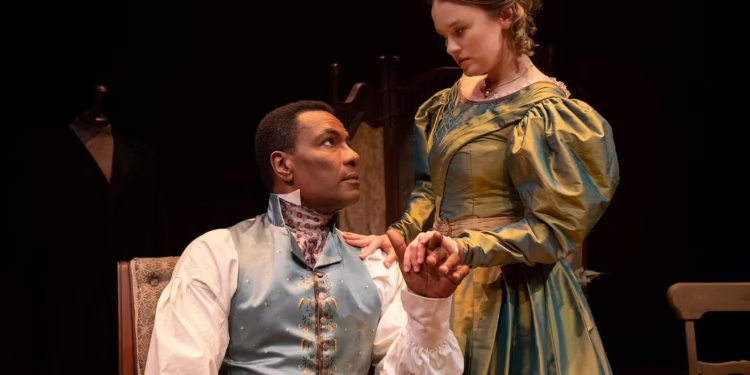Crow’s Theatre
Get to Toronto’s Crow’s Theatre for an incredible and enlightening performance about a ground-breaking actor no one has heard of!
I’ve been an actor, director, educator, and avid student of theatre history most of my life. I thought I knew about or had heard of most of the heavyweights of 19th-century British and American theatre – Edwin Booth (brother of the man who assassinated Abraham Lincoln) Herbert Tree, Edmund Kean, Ellen Terry, Lionel Barrymore, and others.
But before last night’s performance of Red Velvet, I had never heard of Ira Aldridge, his life and controversy. The man, who broke barriers in the 19th century and paved the way for fellow African American performers, is brilliantly revived in playwright Lolita Chakrabarti’s timely and thought-provoking 2012 play, ‘Red Velvet’, now playing at the Crow’s Theatre until December 18.
New York-born Aldridge was the first black actor to play many of Shakespeare’s leading roles, most notably Othello (typically played by white actors in blackface well into the 20th century) in 1833 at London’s Theatre Royal, Covent Garden. Racist campaigns ensued, due in part to the hostile feelings of the imminent abolition of slavery in the colonies. Although most audiences reacted favourably to Aldridge, most critics were vitriolic in their reviews, wanting to “annihilate” and “drive him from the stage” and decrying his performance as “sacrilege”.
Despite these racist diatribes, by the 1840s Aldridge had performed for royalty across Europe, made audiences laugh and weep and was widely regarded as one of the great actors of his age. His career was exceptional, and not just for being a black actor at that time. He travelled farther, was seen by audiences in more countries and won more medals, decorations, and awards than any other actor of his century!
How is it that this 19th-century great was all but erased from history? This stellar production sheds some (gas)light.
In her notes, Director Cherissa Richards reveals the play explores “great love, deep bonds of friendship, and a hunger to achieve greatness”. She has certainly achieved the latter.
Performed by a cast of 8 luminaries (many playing multiple roles) from the likes of the Shaw and Stratford festivals, with spot-on period costumes and props, the play opens in a theatre dressing room in the town of Łódź, Poland in the year 1867. A young female journalist, Halina, has tricked a stagehand into letting her into the room so she can meet the famous actor Aldridge, who has come to perform Lear, in hopes of securing an interview. While Ira at first tries to eject her from his dressing room, he agrees to grant her an interview. Halina mentions Ira’s performance as Othello at Covent Garden, over thirty years earlier. She refuses to drop the subject, and Ira throws her out.
From there we are transported to the stage of Theatre Royal, 1833 and Aldridge’s arrival to join the company of ‘Othello’, amidst loud anti-slavery protests outside the theatre and dissension inside amongst the company.
Richards adeptly handles abolitionist unrest of pre-Victorian England. Her staging is impeccable (not a bad sightline that I could see) and makes full use of the entire stage with natural blocking and wonderful attention to detail. Lead actors aren’t always the centre of my attention. I like to look at what the supporting characters are up to.
Richards created captivating moments from supporting actors who were not the focus of the scene but nonetheless were still in the moment, speaking volumes with their silent facial and physical reactions. Kudos also to the brilliant scene changes, performed exclusively by the company as they whisked furniture and props on and off while interacting with each other and continuing the narrative as they set up for the next scene. Pure genius!
On an equal level of genius were the set and props, provided by Julie Fox. The scenes play out mostly on a Victorian-era proscenium stage complete with wood slat floors and brick walls, fly ropes, barrels, boxes, and other backstage paraphernalia adorning the upstage wall. A luxurious red velvet curtain adorning the outermost proscenium harkened images of the Ford’s Theatre where Abraham Lincoln was assassinated in April 1865. Lanterns, chairs, desks, and even the tea service disclosed dedication to authenticity. Costumes by Ming Wong were resplendent and appropriately lavish. Scarlett O-Hara-style dresses on the ladies and vests and tailcoats on the gentlemen were spot-on period-specific. Fervent attention was obvious to the fabric and weight of each costume, especially Aldridge’s Othello and Lear robes. Gorgeous!
The muted but stunning lighting design by Arun Srinivasan transported us back and forth through time and space. Until the 1880s theatres were illuminated by oil and gas-lit lanterns and candles. Lighting a play that takes place before the dawn of electric lights using modern instruments is no mean feat. Srinivasan’s recreation of soft, amber tones in the backstage scenes and flickering, shadowy candlelight from the footlights during the Othello scene authentically mimicked the era adding an additional layer of realism and emotion to the scene. Thomas Ryder Payne’s superb and supportive sound design, from the subtle rain effects before the curtain to the musical interludes during scene changes met the challenge of keeping pace with the narrative while elevating the play’s unsettling conclusion.
The cast is equally up to the challenge. As Aldridge, Allan Louis certainly has the booming voice, grace, and stage presence worthy of the esteemed actor whom he is portraying. His restrained resentment and vulnerability of an artist long-tortured by prejudice were wonderfully conveyed. His energy and pace were at a continually high level, often with fever-pitch line delivery. Perhaps an added pause here and there could bring more levels to the depth and complexity of his performance.
The supporting cast is all likewise up to the task.
As Pierre Laporte, manager of the Theatre Royal, Kyle Blair, although often soft-spoken and difficult to hear, beautifully imbues tension in a conflicted ally ship with Aldridge. Ellen Denny, playing Ellen Tree, the ingenue and Desdemona to Aldridge’s Othello, is wonderfully spunky and humorous with just the right amount of unctuous curiosity. Amelia Sargisson, in triumvirate portrayals as Halina/Betty/Margaret, was at once giddy, pensive, and curious, while toggling between multiple languages and accents. Wonderful work, especially as the giddy, self-absorbed Betty. Although more volume and distinctive changes in costume/wigs in her transformation to Margaret would have made her singular portrayals more obvious.
Jeff Lillico is perfectly bombastic and repugnant as Charles, the entitled son of Edmund Kean with his puffed-up self-expression, racist diatribes, and all-out temper tantrum. So likably unlikeable! Patrick McManus in dual roles of Aldridge’s valet and dresser Terrence and conservative thespian Bernard, embodies equal parts devotion, stoicism, humour, and volatility. Nathan Howe, also in dual roles as German stagehand Casimir and conservative English actor Henry Forrester, is hilarious. His physical and comedic timing, especially as the foppish Henry, is a standout. His moments shunning Ellen’s romantic advances are priceless. As the ever-present, silent maid Connie, Starr Domingue, brings an understated, indignant portrayal (with a curiously Jamaican patois in her Trinidadian accent!) all the while making the most of her brief scene with Aldridge. Additional shout-outs to the stage management team of Jennifer Parr and Farnoosh Talebpour, who worked so hard having props ready to move on and offstage and making magic with some uber-fast costume changes.
Don’t miss this play! ‘Red Velvet’ needs to be seen! The legacy of this ground-breaking and important American needs to be told! It’s never been timelier in today’s world of equity, diversity, and inclusivity!
Aldridge’s tale is a love letter to theatre, a captivating tale of racism, stereotyping, tension, tenacity, and achievement. A cautionary tale of how much and how little has changed in almost two hundred years.
Running time: approximately two hours and twenty minutes with one intermission.
‘Red Velvet’ runs until December 18 at Crow’s Theatre, 345 Carlaw Avenue, Toronto. For tickets, visit crowstheatre.com or call 647-341-7390 ex. 1010
RED VELVET by Lolita Chakrabarti
Cherissa Richards – Director
Julie Fox – Set and Props Designer
Ming Wong – Costume Designer
Arun Srinivasan – Lighting Designer
Thomas Ryder Payne – Sound Designer
Rais Clarke-Mendes – Assistant Director
Siobhan Richardson – Fight Director
Lisa Nighswander – Head of Props
Chris Faris – Head of Wardrobe
Jennifer Parr – Stage Manager
Farnoosh Talebpour – Assistant Stage Manager
The Cast:
Kyle Blair – Pierre Laporte
Ellen Denny – Ellen Tree
Starr Domingue – Connie
Nathan Howe – Casimir / Henry Forrester
Patrick McManus – Terrence / Bernard Warde
Jeff Lillico – Charles Kean
Allan Louis – Ira Aldridge
Amelia Sargisson – Halina Wozniak / Betty Lovell / Margaret Aldridge
















